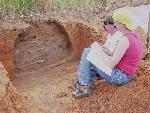Anthropologists dig trash, treasures
By Glen Sharp
The Sunflower June 9, 2004
Click for
a larger copy of the picture in the paper
*  A centuries-old
trash pit near a Harper County ditch holds some
A centuries-old
trash pit near a Harper County ditch holds some
surprise’s for the group excavating it.
Sarah Meiti opened the trash bag of dirt, dipped a coffee can into
it to take a sample and passed the bag to Marcia Meier, who was standing ankle-deep
in red mud. Meier poured the dirt into her sifting box and gently worked her
hands through it, allowing the loose dirt to fall through the screen bottom.
She then sprayed the remaining clumps with water.
Left on the screen were some pieces of pottery, animal bone and turtle
shell — or so the anthropology students said. To an untrained eye the
artifacts might look like small rocks. By themselves the pieces aren't valuable,
but when combined with the rest of the artifacts collected from 4 1/2 tons of
Harper County dirt, they form a picture of the tribal people who lived in the
area around the year 1300.
When Wichita State students and faculty and other volunteers traveled
to Anthony, an hour and a half southwest of Wichita, near the Oklahoma border,
a few weeks ago to excavate a roadside ditch outside town, they hit a trove.
“You never get it this good," said anthropology professor Don Blakeslee,
who spearheaded the 12-member dig.
The recovered artifacts (pottery, tools, animal bones, charcoal.) fill
two long tables in Blakeslee's Neff Hall lab in addition to multiple screen-bottomed
trays. The site consisted of a "classic bell-shaped cache pit [trash pit]
where they dug a small opening and then dug down and extended it out,"
student Brent Weeks said.
Because the side of the pit was opening into the ditch, the group was
able to see a cross section of it. "If we had just dug down in that cache
pit we would have gotten idea going down layer through layer but we wouldn't
have had as good an image of the shape of it," Weeks said.
The big discovery, Blakeslee said, was that the ancient people were
taking home large rocks from 50 or 60 miles away, as compared to going to a
quarry and working the rocks there.
None of the professional or volunteers on the dig team had ever been
aware of that sort of behavior. "It literally stopped us cold," Blakeslee
said.
The theory they developed is that the quarry was in an enemy tribe's
territory and the Harper County tribe had to sneak in and steal the stone, which
was necessary for prehistoric economies.
The dig site had been spotted by an archaeologist driving past the
ditch. He noticed artifacts washing into the ditch and alerted the Kansas Antiquities
Commission, which safeguards sites. Commission members and the WSU anthropology
department then scrounged up some funds to make a field school out of it (one
credit hour for the dig, three credit hours for the dig and analyzing artifacts
in a lab).
From May 24 to 28, the dig group camped out on an Anthony school playground,
waking at 6 a.m., working 8 a.m. to 4 p.m., then showering and eating dinner
before hitting bed around 10 p.m.
"There were a couple of days that were pretty hot; one day we
got back to town and the bank thermometer said 101," said Norm Conley,
a retired aeronautical engineer who's taking anthropology classes for fun.
The group surveyed the area, divided it into units called features
and sifted through about two tons of dirt before the trip ended. The remaining
2 1/2 tons was bagged and brought back to Wichita, where members of the group
spent all of Saturday in Week’s back yard combing through it. (He volunteered
his yard because he wanted to use the dirt to fill in a low spot.)
There were enough tiny artifacts found Saturday to lower Blakeslee's
Honda closer to the ground, Conley said.
Anthropology students will spend the next few weeks cleaning and cataloging
the artifacts. At some point the department will compare its finds with those
collected from the Anthony area in the 1960s, which are housed at the state
historical society in Topeka. In the end, the recent artifacts will also be
given to the historical society.
"Most of the information that can be gathered from this stuff
is not the item itself," Conley said. "It's the item, where it was
found, what it was found in conjunction with, and what arrangement of other
items — that's where the science comes in.”
At some point, members of the group will return to Anthony to show
their finds to the locals, who. Were excited by the dig, While there, Blakeslee
offered to assess artifact collections. People trickled in at first, but after
the Anthony newspaper publicized the dig, amateur anthropologists poured in
— everyone in town except the mayor, Blakeslee joked.
The dig is one of three to four the anthropology department sponsors
every year, including annual ones in Yellowstone National Park and Texas. Anthony
may even warrant a return visit.
"There's certainly enough stuff on the other side of the road
to do it again in another year if we had the funding," Blakeslee said.
"Whether there will be funding is another matter."
For photos of the excavation, visit http://www.normconley.info.
 A centuries-old
trash pit near a Harper County ditch holds some
A centuries-old
trash pit near a Harper County ditch holds some